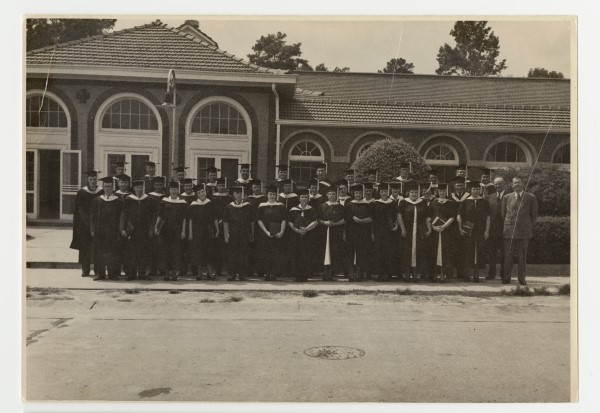
On August 22, 1929, the ECTC Board of Trustees approved a faculty proposal for an additional year of study leading to a state-approved graduate certificate. President Robert H. Wright endorsed this proposal in part because school districts were increasingly giving preference in hiring to the most academically qualified candidates. To ensure that its program was competitive, ECTC needed a graduate curriculum supplementing its undergraduate program in teacher education. Once approved, graduate work was offered during the summer sessions to accommodate in-service teachers with bachelor’s degrees. In 1933, Deanie Boone Haskett (1904-1986), an ECTC alum, Class of 1926 and former editor-in-chief of the Teco Echo, became the first to earn a master’s degree. As her graduate thesis, Haskett, a double major in English and French, completed a study of North Carolina Poetry. Graduate instruction continued during the 1930s, but so did the depression, putting a damper on the new program. However, Haskett went on to become a teacher at Greenville High School (later, J. H. Rose High) and a critic teacher at ECTC, well validating with her successful career in teaching the new graduate option.
When the N. C. Department of Public School Instruction raised professional standards for school administrators, principals, and supervisors by requiring a master’s degree for those positions, ECTC revamped its graduate program to meet the new standards. The first graduate bulletin, published in 1941, announced two tracks: one for teachers seeking graduate certification, and the other for those not interested in certification. Dr. E. L. Henderson of the Department of Administration and Supervision, was named director of the graduate program. Henderson was assisted by a committee of five department directors. The bulletin listed thirty-five graduate faculty offering instruction in administration and supervision, education, English, geography, history, mathematics, psychology, natural science, and social science. Through this expanded program, ECTC pioneered a curriculum leading to the highest grade of certification awarded by the State Department of Public Instruction for teachers, principals, and administrators in public schools.
Responding to increasing numbers of students who were not interested in teaching, ECTC established an alternative bachelor’s degree that did not entail teacher certification. The alternative program offered a B.S. degree rather than a B.A., with the requirement that a minor be substituted for education courses and practice teaching that would otherwise lead to the B.A. and teacher certification. The non-teaching B.S. degree was the counterpart of the master’s program without teacher certification. With this non-teaching curriculum, ECTC moved, at both the undergraduate and graduate levels, beyond the bounds of a teachers college and towards one characteristic of a four-year liberal arts institution, i.e., a college.
In 1941, the Daily Reflector ran an announcement that ECTC was one of six North Carolina colleges and universities accredited to offer graduate work. The others were the University of North Carolina, Woman’s College (later, UNC-G), North Carolina State College (later, NCSU), Duke University, and Wake Forest College. Although still a teachers college, East Carolina ranked with five more prestigious schools, including two universities, at least in terms of graduate accreditation for teachers and school administrators.
During the late 1940s and the 1950s, President John D. Messick sought to expand graduate instruction further. A new director of graduate studies, Dr. Joseph K. Long, was appointed. In 1947, Messick’s first year as president, a total of 18 master’s degrees were awarded. However, five years later, in 1952, East Carolina, by then a four-year liberal arts college with a strong program in teacher education, conferred 112 graduate degrees. In 1953, preparations began for a new curriculum leading to a doctorate in education (Ed.D.). With this development, East Carolina College was moving toward the highest levels of educational service. Shortly after, the Rocky Mount Evening Telegram ran an editorial, “East Carolina College – A University For The East,” noting how Messick wanted to see East Carolina assume the proportions of a university serving the people of eastern North Carolina.
With Messick’s successor, Dr. Leo W. Jenkins, university status was achieved and with it, a vastly expanded graduate school coordinating graduate level instruction across the campus. In 1965, Hubert Everett Walters became the first African-American student to complete a graduate degree at ECU with his master’s degree in music education. In 1970, an African-American alumnus, Dennis E. Chestnutt, enrolled in the master’s program in psychology, further pioneering the transformation of graduate instruction away from the limits of Jim Crow higher education toward new levels of inclusiveness and diversity that remain defining features of the university and its graduate curriculum. Chestnutt later earned his Ph.D. at the University of Utah and joined the ECU faculty in psychology. Once again, student successes validated the worth and integrity of East Carolina’s devotion to educational service.
Currently, ECU has nearly 6,000 graduate students and annually awards over 1,000 master’s degrees, nearly 300 doctoral degrees annually. Educational levels in eastern North Carolina as well as the state have been significantly expanded by ECU’s burgeoning graduate curricula.
Sources
- Bratton, Mary Jo. East Carolina University: The Formative Years, 1907-1982. Greenville, N.C.: East Carolina University Alumni Association, 1986.
- “Dr. Dennis E. Chestnut oral history interview, April 23, 2008.” University Archives # 45.05.01.3. J. Y. Joyner Library. East Carolina University. Greenville, N.C. https://digital.lib.ecu.edu/1254.
- “ECC: A University For The East.” Rocky Mount Evening Telegram. May 21, 1953. P. 4A.
- Ferrell, Henry C., Jr. No Time For Ivy: East Carolina University, 1907-2007. Greenville, N.C.: East Carolina University Alumni Association, 2006.
- “Offering Degree in Liberal Arts Here This Year.” Teco Echo. October 3, 1941. Vol. 18, no. 1. P. 1. https://digital.lib.ecu.edu/37893.
- “The Summer School Commencement Held: First M.A. Degree Conferred This Summer.” Teco Echo. September 27, 1933. Vol. 10, no. 1. P. 1. https://digital.lib.ecu.edu/38007.
Citation Information
Title: Graduate Degrees
Author: John A. Tucker, PhD
Date of Publication: 7/18/2019